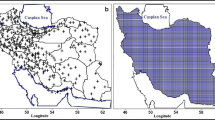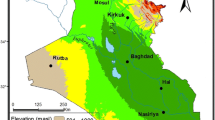Abstract
Temperature is one of the key elements of climate formation and its changes can alter the climate structure of each region. To study the trend of temperature changes in Iran, the data from the three variables of average minimum temperature, average maximum temperature and average annual temperature of 43 synoptic stations were obtained from the Iranian Meteorological Organization for a 48-year statistical period (1966–2016). Moreover, in order to detect the trend of average changes of minimum, maximum and annual temperatures, fuzzy possibilistic regression and classical linear regression models were used. The comparison of the results of the slope of the change trend obtained from the two models clearly showed that, in most cases, the fuzzy possibilistic regression shows the slope of the change trend more than the classical linear regression. The statistics of root-mean-square error also showed that the function of classical linear regression was much better than fuzzy possibilistic regression. Therefore, based on the results of classical linear regression, the maximum amount of the average change trend of maximum annual temperatures of Iran is first observed in the west and northwest, and then in the northeastern of Iran. However, the average trend of minimum annual temperatures in Iran has shown more different spatial configurations than the average of maximum annual temperatures in Iran, with the highest rates of change in the east half, especially in the northeast. Finally, based on the classical linear regression model, it was observed that in the whole study period, 1.40 °C has been added to the average of maximum annual temperatures and 1.68 °C to the average of minimum annual temperatures in Iran.








Similar content being viewed by others
References
Alijani B, Mahmoudi P, Panahi A (2011) Investigation of displacement of minimum temperatures temporal and spatial cores in west and northern west of Iran. Geogr Environ Plan J 41:53–68 (In Persian)
Alijani B, Mahmoudi P, Salighe M, Rigi Chahi A (2012) Study of annual maximum and minimum temperature changes in Iran. Geogr Res 26:101–122 (In Persian)
Alizadeh A, Kamali G (2002) Effect of climate change of agricultural water use in Mashhad valley. Geogr Res 2–3:189–201 (In Persian)
Bidokhti AA, Ranjbar AA (2003) Study of climatic effect of heat island for Tehran. In: Third regional and first national conference on climate change, 21–23 October, Isfahan, Iran (In Persian)
Brazdil R, Budikova M, Fasko P, Laplin M (1995) Fluctuation of maximum and minimum air temperatures in the Czech and the Slovak Republics. Atmos Res 37:53–65
Domonkos P, Tar K (2003) Long-term changes in observed temperature and precipitation series 1901–1998 from Hungary and their relations to larger scale changes. Theor Appl Climatol 75:131–147
Domroes M, El-Tantawi A (2005) Recent temporal and spatial temperature changes in Egypt. Int J Climatol 25:51–63
Easterling DR, Horton B, Jones PD, Peterson TC, Karl TR, Parker DE, Saliger MJ, Razuvayev V, Plummer N, Jamason P, Folland CK (1997) Maximum and minimum temperature trends for the globe. Science 277:364–366
Freiwan M, Kadioğlu M (2008) Climate variability in Jordan. Int J Climatol 28:69–89
Gemmer M, Becker S, Jiang T (2004) Observed monthly precipitation trends in China 1951-2002. Theor Appl Climatol 77:39–45
IPCC (2001) In climatic change 2001: the scientific basis. University Press, Cambridge
Jiang JM, You XT (1996) Where and when did an abrupt climatic change occur in China during the last 43 years? Theor Appl Climatol 55:33–39
Jones PD, Moberg A (2003) Hemispheric and large-scale surface air temperature variations: an extensive revision and an update to 2001. J Clim 16:206–223
Kadioğlu M, Şen Z, Gültekin L (2001) Variation and trends in Turkish seasonal heating and cooling degree-days. Clim Change 49:209–223
Kumar PV, Bindi M, Crisci A, Maracchi G (2005) Detection of variations in air temperature at different time scales the period 1889–1998 at Firenze, Italy. Clim Change 72:123–150
Lettenmaier DP, Wood EF, Wallis JR (1994) Hydro-climatological trends in the continental United States, 1948–1988. J Clim 7:586–607
Masoudian SA (2004) Temperature trends in Iran the last half century. Geogr Dev 2:89–106 (In Persian)
Nasri M, Modarres R (2008) Dry spell trend analysis of Isfahan Province, Iran. Int J Climatol 29:1430–1438
Nicolas N, Gruza G, Jouzel J, Carl T, Ogallo L, Parker D (1996) Observed climate variability and change. In: Houghton J, Meira Filho L (eds) IPCC 1995. The Second IPCC scientific assessment of climate change. Cambridge University Press, Cambridge
Rahmstorf S, Ganopolski A (1999) Long-term global warming scenarios computed with an efficient model. Clim Change 43:353–367
Scheifinger H, Menzel A, Koch E, Peter C (2003) Trends of spring time frost events and phonological dates in central Europe. Theor Appl Climatol 74:41–51
Shirgholami H, Ghahraman B (2005) Study of time trend changes in annual mean temperature of Iran. JWSS-Isfahan Univ Technol 9:9–24 (In Persian)
Stern DI, Kaufmann RK (2000) Detecting a global warming signal in hemispheric series: a structural time series analysis. Clim Change 47:411–438
Tanaka H, Uejima S, Asai K (1982) linear regression analysis with fuzzy model. IEEE Trans Syst Man Cybern 12:903–907
Tavosi T, Mahmoudi P, Moghadam FS (2010) Comparison of spatial spreading of arid and semi-arid climates in Iran during 1976–2005. Iran J Range Desert Res 17:94–105 (In Persian)
Tayanç M, Im U, Doğruel M, Karaca M (2009) Climate change in Turkey for the last half century. Clim Change 94:483–502
Todisco F, Vergni L (2008) Climatic change in central Italy and their potential effects on corn water consumption. Agric For Meteorl 148:205–209
Tonkaz T, Çetin M, Tülücü K (2007) The impact of water resources development projects on water vapor pressure trends in a semi-arid region, Turkey. Clim Change 82:195–209
Türkes M, Sümer UM, Kiliç G (2007) Variations and trends in annual mean air temperature in Turkey with respect to climatic variability. Int J Climatol 15:557–569
Walter GR, Post E, Convey P, Menzel A, Parmesean C, Beebee TJ, Formentin JM, Hoegh-Guldberg O, Bairlein F (2002) Ecological responses to recent climate change. Nature 416:389–395
Zadeh LA (1965) Fuzzy sets. Inf Comput 8:338–353
Zhang Q, Xu CY, Zhang Z (2009) Observed changes of drought/wetness episodes in the Pearl River basin, China, using the standardized precipitation index and aridity index. Theor Appl Climatol 98:89–99
Acknowledgements
The authors wish to thank all who assisted in conducting this work.
Author information
Authors and Affiliations
Corresponding author
Additional information
Editorial responsibility: Mohamed Fathy Yassin
Rights and permissions
About this article
Cite this article
Mahmoudi, P., Mohammadi, M. & Daneshmand, H. Investigating the trend of average changes of annual temperatures in Iran. Int. J. Environ. Sci. Technol. 16, 1079–1092 (2019). https://doi.org/10.1007/s13762-018-1664-4
Received:
Revised:
Accepted:
Published:
Issue Date:
DOI: https://doi.org/10.1007/s13762-018-1664-4




